|
“Following the light of the Sun, we left the Old World.” -Christopher Columbus |
Recently, I’ve been approached by a friend of mine who has started a solar energy company called Solar Divide. They focus on the hybridization of existing solar farms through the combination of solar thermal systems with traditional solar panels. I am interested in joining their team, but before I do so I want to make sure that their current product–the Dual Spectrum Solar Harvester–is a sound investment both scientifically and economically.
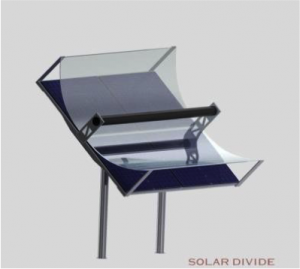
The Dual Spectrum Solar Harvester (DSSH) expands the range over which solar irradiance can be absorbed and converted into electricity. Understanding that photovoltaic cells capture energy from the visible light spectrum, traditional solar panels lose a large portion of the spectrum in the infrared and ultraviolet ranges.
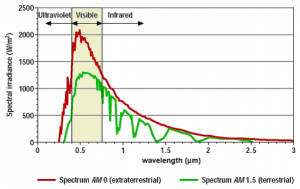
In order capture this lost energy, DSSH replaces the mirrored trough used in traditional concentrated solar power (CSP) systems with a visibly transparent, infrared and ultraviolet reflective trough that could be placed over new or existing photovoltaic solar panels. This allows for the simultaneous collection of photovoltaic and thermal energy.
Understanding all of this, I am left with a few questions and concerns:
- How does this integration of these two technologies (CSP and PV) impact the overall efficiency?
- What can be done to ensure that this system maximizes its energy conversion to electricity?
- What constraints does solar generation face with respect to generation and demand slates?
- Lastly, how does storage of energy impact the system and electrical grid as a whole?
Overall, many of these questions can be analyzed through the understandings of process control. So, let’s think about this…
In terms of process control: What Are Our Significant Variables?
|
Manipulated Variables |
Controlled Variable | Deviation Variables |
| Incident Angle of Paneling |
Electricity Output |
Insolation |
| Energy to Storage/Grid |
Cloud coverage |
|
| Flow Rate of Working Fluid through pipe | Electricity Demand |
With solar panels, the main variable that we are trying maximize is the output of electricity that goes into the power grid. This too is true for concentrated solar thermal systems, however, intermediate controlled variables are necessary to convert the heat into electricity.
But before we talk about power generation, it’s important to understand the demands of the electrical grid. Throughout the day, everyone uses electricity at different magnitudes which poses a disturbance to the generation of that grid (see Figure below).
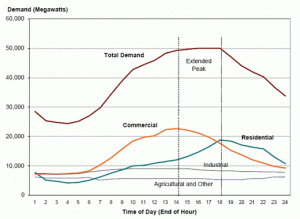
This large flux in energy demand makes solar generation a true process control issue. To account for this, many solar generation plants use certain types of storage or battery management systems in order to have what is know as “dispatchable” energy. In general, the below schematic demonstrates the general layout of a typical photovoltaic solar farm.
However, the product that Solar Divide is attempting to create combines the typical solar farm with the parabolic trough. Even though the issue of electricity demand slate still remains, let’s look into the variables that affect the power generation of CSP.
Since the main source of power–solar radiation–cannot be controlled, the only simple controllable variable on the DSSH then becomes the flow of fluid within the solar receiver. This fluid flow can then be optimized so as to help increase the efficiency of thermal storage and power generation.
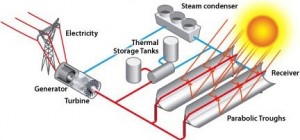
The main purpose of a control system on the DSSH would then be to maintain the outlet oil temperature at a desired set point in spite of disturbances from the environment. Since many variables such as (1) the solar irradiance level, (2) the mirror reflectivity, and (3) the inlet oil temperature all can impact the outlet temperature, it is difficult to maintain a desired output with a fixed parameter controller. Since a controller’s response rate and dead time have high oscillations and variation, they must be detuned with low gain and therefore retain sluggish responses in order to compensate for the various environmental factors.
So, you may be wondering…where does one even start to be able to model a system like this?
It’s simple. We start with a balance of energy. (The following equations may be attributed to Camacho et al. and the full citation may be found at the end of this post.)
One must first dilineate all of the heat flows in and out of the system. This may be understood to be in the equation below:

- T is the outlet temperature of the field
- Tin is the inlet tem- perature.
- C is the heat capacity of the field
- I is the solar radiation
- Sfi the total reflective surface of the field
- Kopt is the optical efficiency of the mirrors
- no is a parameter taking into account the cosine of the incidence angle between the sun vector and the solar field
- q is the oil flow
- ρf and Cf stand for the density and the specific heat of the fluid respectively
- Hl is the thermal loss coefficient
- Tm is the mean value between inlet and outlet temperature
- Tamb is the ambient temperature.
It may seem difficult at first, but in the words of Albert Einstein, “To keep your balance, you must keep moving.” This balance can then be solved to find the equation for the flow rate of the working fluid (the manipulated variable) through the DSSH:
 Where,
Where,

Finally the controlled output (production electricity) can then be calculated using the following equation where E stands for the electricity required to pump the working fluid.
![]()
Once experimentally run, the below equations can be used to find the actual production of electricity with the appropriate efficiencies taken into account.
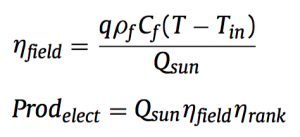
Once an understanding of how this input can affect the output of electricity production, a series of controllers can be put into place so as to ensure that the maximum of output is achieved through the modulation of the flow rate of the working fluid. And if you’re interested in finding out how this is done, please check out my other blog posts!
Please see below for relevant readings:
Xuping Li, Mark Paster, James Stubbins, The dynamics of electricity grid operation with increasing renewables and the path toward maximum renewable deployment, Renewable and Sustainable Energy Reviews, Volume 47, July 2015, Pages 1007-1015. Abstract: This paper presents an overview and analysis of the dynamics and unique impacts of variable renewables on the grid, and identifies the bottleneck problems and solutions associated with renewable integration. Variability issues that concern many are not unique to variable renewables. Grid operators have been dealing with demand variability for over a century. With sufficiently accurate forecast for variable renewables, the grid operators can schedule dispatchable generation and/or storage resources to balance demand and supply on a nearly real-time basis. With state-of-the-art wind forecasting technologies and existing generation resources, wind integration has not caused major operational problems for grid systems with a penetration level of up to 37% during some time intervals. Base load generators operate nearly constantly for days or longer and supply a larger share of the electricity mix than what is proportional to their capacity. This will be a limiting factor for high level variable renewables, if current operation continues. The capability to at least partially follow electricity load should be a key performance measure of non-renewable plants if we are serious about high level variable renewables. Specific policy instruments are recommended to incentivize more flexible plant operation and ensure smooth integration of variable renewables.
Nikolaos S. Thomaidis, Francisco J. Santos-Alamillos, David Pozo-Vázquez, Julio Usaola-García, Optimal management of wind and solar energy resources, Computers & Operations Research, Volume 66, February 2016, Pages 284-291. Abstract: This paper presents a portfolio-based approach to the harvesting of renewable energy (RE) resources. Our examined problem setting considers the possibility of distributing the total available capacity across an array of heterogeneous RE generation technologies (wind and solar power production units) being dispersed over a large geographical area. We formulate the capacity allocation process as a bi-objective optimization problem, in which the decision maker seeks to increase the mean productivity of the entire array while having control on the variability of the aggregate energy supply. Using large-scale optimization techniques, we are able to calculate – to an arbitrary degree of accuracy – the complete set of Pareto-optimal configurations of power plants, which attain the maximum possible energy delivery for a given level of power supply risk. Experimental results from a reference geographical region show that wind and solar resources are largely complementary. We demonstrate how this feature could help energy policy makers to improve the overall reliability of future RE generation in a properly designed risk management framework.
Eduardo F. Camacho, Manuel Berenguel, Antonio J. Gallego, Control of thermal solar energy plants, Journal of Process Control, Volume 24, Issue 2, February 2014, Pages 332-340. Abstract: This work deals with the main control problems found in solar power systems and the solutions proposed in literature. The paper first describes the main solar power technologies, some of the control approaches and then describes the main challenges encountered when controlling solar power systems.
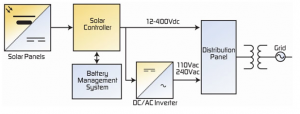
This is another awesome idea but the article itself is pretty dense with equations and it’s hard to get a full understanding of the idea of this combination solar panel. The general idea seems to be to obtain more energy by taking advantage of not only the visible light spectrum, but also the infrared and ultraviolet energy coming from the sun. My first question is also the same as the first question in this article. How does the integration of the concentrated solar panel and photovoltaics impact the efficiency? Would the transparent film that is used to concentrate the ultraviolet and infrared waves affect the amount of visible light that reaches the photovoltaic solar panels below? This is a question raised and not entirely answered within this blog entry. Sure it is connected to the equations mentioned but the fundamental yes or no answer was never given. If the answer to this question is in fact yes, then the entire idea of the combinations of CSP and PV falls apart as efficiency is a main variable to consider in any system. This would be an indication that it would just be more efficient to just make a separate section in a solar farm for each type.
On an unrelated note, I really enjoyed reading this and I am interested in reading your other blog posts and hopefully more on each controller at their respective locations within the system. I assume that almost every controller will be a PI controller as the system itself does not respond well to oscillation so the derivative action portion of the controller would not be so helpful and would just cause more oscillation. So all that would be left is to tune each controller’s parameters.
The working fluid in the system described in this article is oil which is then used to heat up water to make steam to run turbines if I am interpreting the diagram correctly. I think it is a brilliant idea to introduce process controls to the system to regulate the flow rate of the oil so that the output temperature can be constant. Although there are many disturbances in a system like this so the controller network will have to be fairly complex.
One last comment I would like to make is that the introduction to DSSH in the beginning of the article seems kind of irrelevant. The beginning of the article mentions it as if this is the technology that will be implementing process controls but then the focus of the article shifts to the process of generating electricity from solar panels as a whole and the implementation of process controls is talked about with a broad scope of the system which makes me feel like it really doesn’t matter at all if the solar panel is a CSP, PV, or DSSH. I think I would have enjoyed the article more if it was focused more directly on DSSH.
This is a very interesting idea and the angle of approach in terms of introduction and explanation of the technical and practical aspects were both very good. However, a question that should be addressed early on is why should this device be slated as an upgrade to existing arrays when it seems like it could work just as well as a standalone product? The article shows that the add-on is used to harvest light in the spectra that is lost for most photovoltaic panels. This seems to only offer the advantage of being more space efficient and does not provide any additional benefit compared to building another solar farm all while having added complexity. From a laymen perspective, it seems like it would be wiser just to build another solar plant with the capital instead of using this new technology. Would I use it personally? Only under certain niche circumstances where I already have an array and installing additional panels would be very difficult. This is a legitimate problem in many households in Asia that already have photovoltaic panels installed and it would sell very well in places where apartment style housing are prevalent and electricity is not subsidized.
In term of the control aspects, I think you did a very good job of displaying the entirety of the technical behind the new device. The main audience for this seems closer to something between an academic journal and a more esoteric science magazine. For the average technologically inclined reader would have either a difficult time understanding all the equations or would jump past it. Putting this section into a more qualitative point of view would significantly up the readability of the post on top of having a better transition from the earlier part.
In terms of the actual process control, a more thorough understanding design of the system would be required before a control process could be adequately modelled. However, since the only manipulated variable is the flow rate, the control system should be fairly simple. The disturbance would be the intensity of sunlight in each spectra.
I found the article very good in the beginning but the esoteric theory section was a little bit too much for the targeted audience.
Thank you for such an innovative post. I with you and your friend success in commercializing this technology.
From my understanding of the article, the DSSH system is a step up from regular CSP systems based on the fact that it is able to harvest the energy from the ultraviolet and infrared spectra in addition to visible light which would in turn increase its energy output. Assuming that this system is able to successfully increase the efficiency of harvesting solar energy, I am curious to see how significant the margin of improvement would be from regular CSP systems.
Due to the many moving parts of this system, a fairly complex control system will be required to ensure that adequate responses are observed with changes in the set-point and disturbance variables. It seems that you are looking to minimize oscillations as much as possible by using small gains and possibly longer time constants. This is a sound decision as this would make your system stable over a wide range of perturbations. The downside to this approach however-due to the large time constants- is the decreased performance of the system. Going into further detail, the system will have very slow reactivity to disturbances because of the long amount of time required for the error signal to reach the controller. As such, the system will continue to produce an undesired output until the controller is able to rectify the issue. I am not sure of the specifics of the design of either DSSH or CSP systems, but potential risks to the system in this application would be overheating the oil past its boiling point which introduces significant instability into the system.
I think this system would be a good practical application for the feedback-feedforward control loop. The components in the feedforward loop may be set to have faster time responses to ensure that the feedforward controller is able to rectify the problem as quickly as possible (think a lead lag element for the controller transfer function). It is also possible that specific controller outputs could lead to downstream changes in the setup of the DSSH system such as the varying the angle between the panel and the sun based on the cloud coverage and solar intensity of the day to promote more or less energy absorption.
Overall, this article definitely has piqued my interest and I’m hoping to see more qualitative information on the potential control systems to be implemented during the in-class presentation.
With an ever-growing demand of energy, many groups of people are currently looking at ways to harness power from sources that differ from the usual fossil fuel/non-renewables that dominate today’s market. One of the areas in which research has delved into has been the solar sector; with the sun providing significant amounts of energy in the form of light and heat, conducting tests to determine what efficiency and what magnitude of energy could be harnessed could prove very beneficial in the near future. What could have potentially been included in the background of the harnessing of solar power, could have additionally been some numbers that gave a little bit of insight of the panels that are used now. For example, the efficiency generated now, how much energy is harnessed in a day etc. to give the reader a rough estimate as to what obstacle this new invention would have to hurdle to make an impact in the market. Coming now to this new type of solar panel, I cannot say right off the bat if I, or the general public would use it; what was mentioned though was correct in that tests on efficiency and potential be run before being implemented. Based on the description and the way it is set up, I believe that it could have the capability to outperform the existing solar panels that are used today. Here though, another factor would come into play and that would be cost; compared to the panels that are used today, how would they stack up?
The variables are clearly stated as well in the body paragraph that clearly outline what one would be focused on when analyzing the system at hand. After the variables are explained, it becomes a little more difficult to follow with the equations and what is trying to be conveyed. Even though it is important to understand the system first before measurements are put in place, a block diagram with some sort of controller/controllers should have been included to display how the process would try to better the system that is used currently. I would most likely start off with a PI controller of some sort to address the response time to a disturbance and the dampening effect to prevent an overshoot that would likely interfere with the D aspect of the proposed controller. Other than these miniature other pieces of information, very nicely done and can’t wait what will be posted in the next blog!